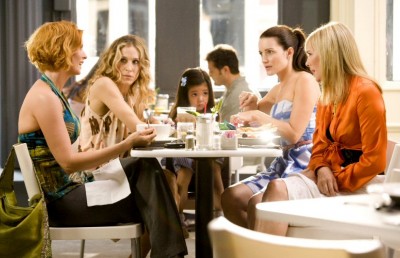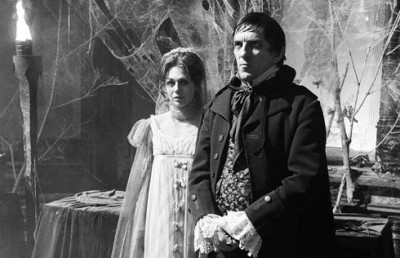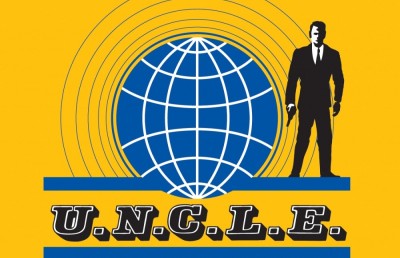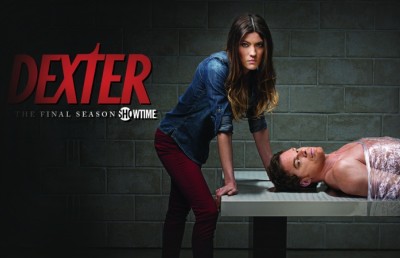Contextual Analysis of An Occurrence at Owl Creek Bridge: Robert Enrico vs. Rod Serling
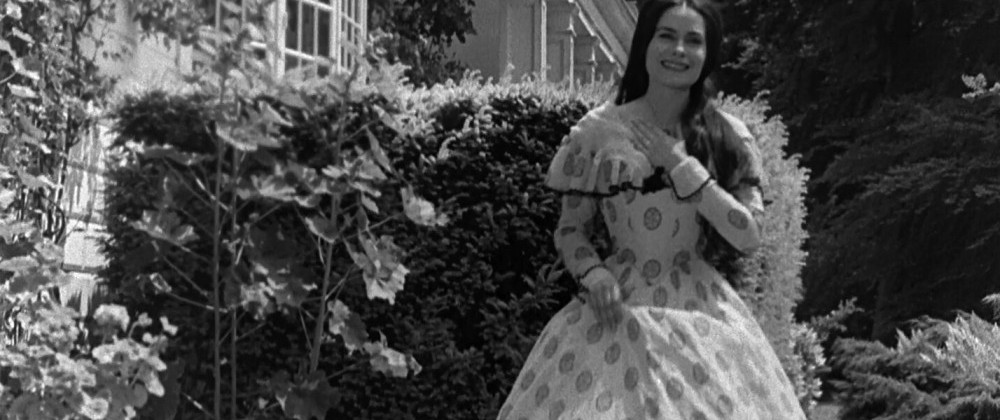
Most people in North America know of the short film based on the 1890 short story by American Ambrose Bierce, An Occurrence at Owl Creek Bridge, through its initial broadcast in 1964 on Rod Serling’s Twilight Zone. Serling was a huge fan of author Bierce and a literary man himself. The film won the 1963 Academy Award for Best Short Film and first prize for Best Short Subject at the 1962 Cannes Film Festival. Serling loved the film and story so much that he made an exception and wanted to run it on his show, which only featured episodes made by the Twilight Zone production team. The producers of Twilight Zone purchased the rights to air it for $25,000 (actually $20,000 for the rights and $5,000 extra for the re-editing) considerably less than the $65,000 it cost for an in-house episode. 1 It aired on February 28, 1964, the only time that a premade film aired on Twilight Zone, which always featured episodes written and directed by in-house people. But to fit the 27 minute short film into the 30 minute television commercial format Serling had to cut it down to approximately 25 minutes. In terms of running time, the original version of An Occurrence at Owl Creek Bridge which was directed by Roberto Enrico in 1962 and titled La rivière du hibou, ran 26’40”, while the version which aired on Twilight Zone on February 28, 1964, ran one minute and ten seconds shorter at 25’30”. How exactly did Serling and the producers of Twilight Zone spend the $5,000 to edit the original film down to this prescribed running time? What did they edit out and change from the original? What follows is a contextual analysis of the two versions to ferret out these changes.
The edits needed to trim down the original of approximately 1’10” occur in three spots in the film, right at the beginning, a few shots right at the end, and a single shot about three-quarters into the film. These three edits of approximately seventeen seconds, twelve seconds and forty one seconds comprise the trimmed footage. But there are other significant changes not dependent on running time which will be noted, mainly the decision to remove all but one instance of subjective voice-over. In the original Enrico version there are five points in the story where we hear Peyton Farquhar’s internal diegetic voice-over, but the Twilight Zone version retains only one of these, when we hear the man call out his wife’s name, “Abby,” which precipitates the memory or flashback image of his wife. There are consequences to this decision, which I will discuss along with other differences in this comparative analysis.
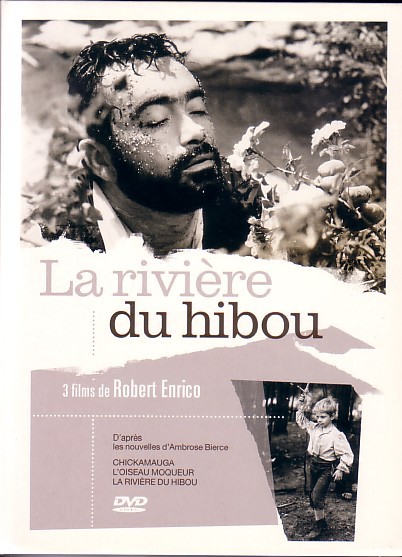
Cover of French PAL DVD
For those unfamiliar (MAJOR PLOT SPOILERS), the film is set during the American Civil War and deals with the hanging of a Southern man accused of attempting to destroy a strategic bridge. The film opens on a bridge with the hanging in process. Soldiers prepare the victim for the bridge hanging, a thirty-something man named Peyton Farquhar. With death imminent, the man remembers his wife and home. As the plank overhanging a river is taken away, the man falls vertically to his supposed death. The noose breaks and he falls into the river below, untangles himself from the noose and manages to elude the Northern gunfire to a shore upstream from where he was felled. He begins to run in the woods toward his wife and home. As he nears his plantation estate his wife becomes visible. His wife appears closer, and closer, they finally meet and embrace, and then we are brusquely snapped back to reality: Farquhar falls to his hanging death at the bridge. Escape was but an illusion, a fantasy, a proverbial “life flashing before one’s eyes.”
The original version begins on a black frame, with off-screen military drumming heard on the soundtrack. The image fades in to a crane shot that moves vertically along a tree, on which hangs a public order by the government condemning to death by hanging any civilian caught interfering with bridges, tunnels, or trains. In the original French version, entitled La rivière du hibou, the sign is written in English, to maintain the realism of the American setting, but at the end we see the sign repeated as an intertitle in French. 2 The camera pauses but never stops on the sign, before continuing its upward craning movement.
In the Twilight Zone version the film starts on a freeze frame close-up of the notice, which lasts about eight seconds, perhaps to give viewers watching the film on a small television screen more time to read the notice, and eliminating the opening black frame and camera movement, shoring approximately 17 seconds from the film right off the top.
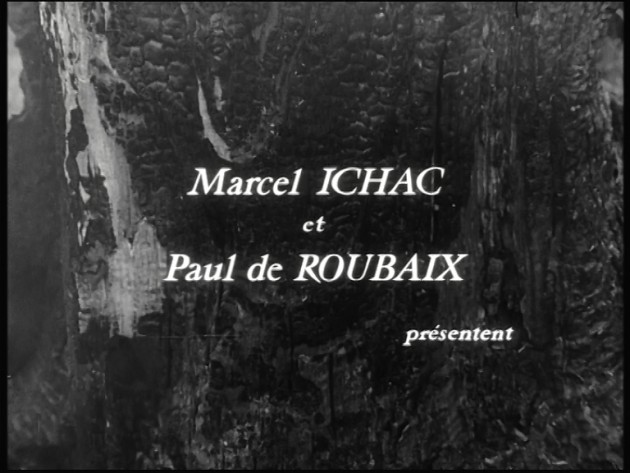
Opening shot of original version
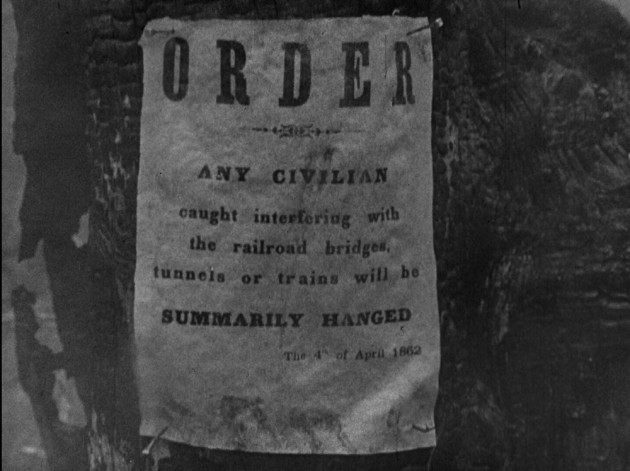
Opening shot of Twilight Zone version
One of the most affective changes between the two versions is the decision in the Twilight Zone version to forego most of the original’s subjective voice-over. The first time we hear any subjective voice-over in the original version is at 5’45” when the man, named Peyton Farquhar, looks at a floating piece of driftwood and describes its movement being carried by the current (perhaps a symbol of his desire for such freedom). A minute later we hear the second VO as he utters the name of his wife, “Abby,” and we cut to an imagined flashback image of his wife seated reading with two children playing in a courtly looking estate front yard. The flashback/memory shot sees his wife seated by a tree –an ironic object given that hangings often take place on them– with a young girl, his daughter, we assume, swaying on a swing on a tree being pushed by a young boy, we also assume, is his son (the swing being another ironic allusion to his imminent hanging). In the far background we see a black slave worker, situating this on a plantation farm (with its hierarchical framing the shot recalls a similar framing in Birth of a Nation).
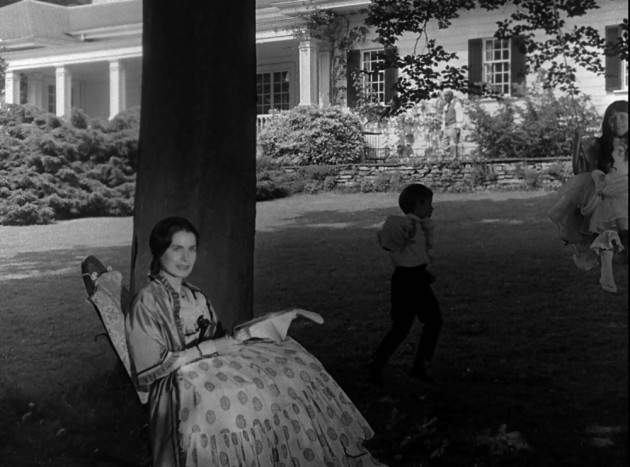
Reference to Birth of a Nation?
As Abby walks toward the camera, the lighting gets brighter, and the sound of a slightly distorted ticking clock increases to heighten the sense of time. The off-screen words of a sentinel, “take his watch” “yes sir” snaps us back to reality. This instance of Peyton uttering “Abby” is the only time in the Twilight Zone version where we hear his voice-over, and was included perhaps because it served the specific plot function of identifying the character in the flashback/memory. The sentinel takes the prisoner’s pocket watch and the scene cuts to a CU of Peyton’s face. In the original we hear a third subjective voice-over at this point, as the condemned man imagines his escape (“If I could free my hands…”) which can be said to increase the subjectivity of the story. The passage in the short story is narrated through an authorial point of view and goes as follows:
If I could free my hands, he thought, “I might throw off the noose and spring into the stream. By diving I could evade the bullets and, swimming vigorously, reach the bank, take to the woods and get away home. My home, thank God, is as yet outside their lines; my wife and little ones are still beyond the invader’s farthest advance.
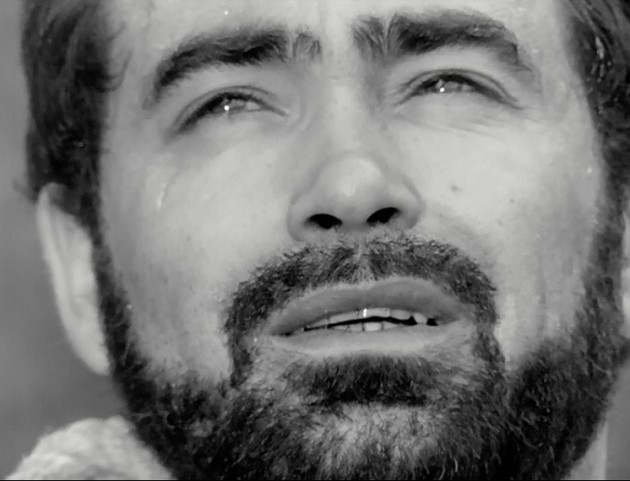
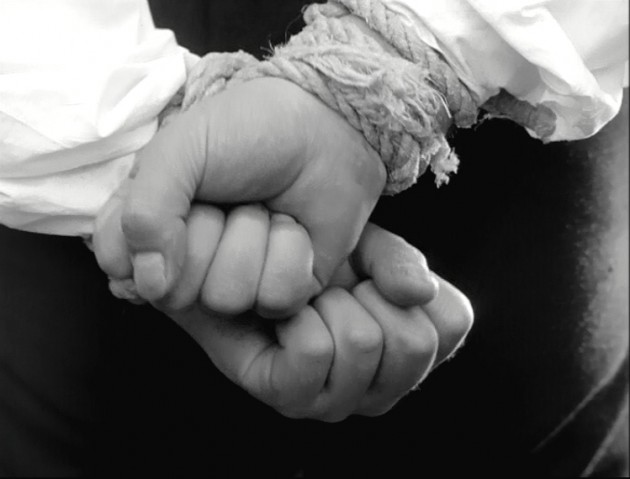
The images that accompany this voice-over is a close-up of Peyton’s face, as he cries mournfully; this is followed by a cut to a close-up of his hands tied behind his back trying to wiggle free of the knot. Hearing the voice-over of the man thinking about escaping gives a completely different nuance to these two shots, almost a Kuleshov Effect, suggesting the possibility of escape. Without the insight into his internal thoughts he appears defeated, without hope. We read his expression, his tears, his tied hands, differently than in the original where his voice-over affords us a glimmer of hope, and adds to the realism of the events.
What these three voice–overs also do is to set up the protagonist’s goal –to reach his family– and increases our empathy for the man. The fourth VO in the original comes when Peyton emerges from the water and sees a soldier about to fire on him. The voice-over relates how the shooter’s eyes are a dark grey and that all great marksmen had dark grey eyes. This explains the following extreme close up of an eye, which follows from a slow zoom in to Peyton’s eyes, as being those of the shooter. In the Twilight Zone version, without the voice-over, the audience must surmise, based on the eyes being of a lighter color than the man’s, that they are the eyes of the shooter, and hence Peyton’s subjective point of view. This line comes directly from the story, but told in third person in the Bierce story, “The man in the water saw the eye of the man on the bridge gazing into his own through the sights of the rifle. He observed that it was a grey eye and remembered having read that grey eyes were keenest, and that all famous marksmen had them.” Hence in this case director Robert Enrico takes a third person line and makes it subjective, since there was no other way for him to relate this information to the viewer –an example of the limits of one medium, literature, compared to another, cinema.
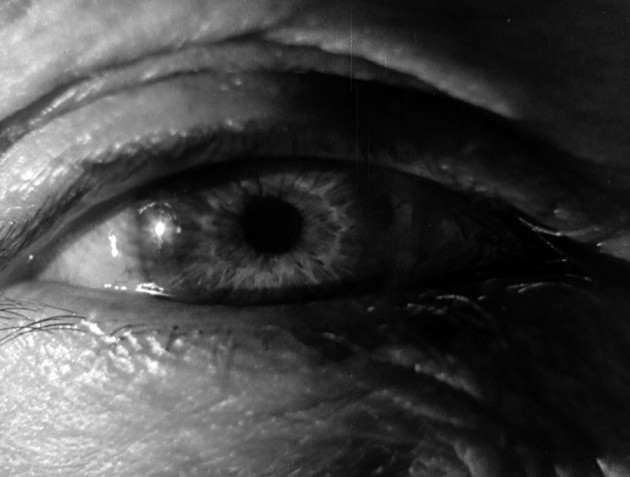
Whose eye?
In both versions the preceding scene contains an odd use of subjective sound: as the soldiers move about the bridge in slow motion we hear them reacting to his escape, but their voices are equally slowed down, slurred, garbled as they plan to hunt down Peyton. (“He must be hanged” “Steady man…he mustn’t escape…there he is, he’s moving. Peyton Farquhart. Your trapped like a rat in a trap.”) The images are taken from water level, low angle, as if we are hearing from his underwater POV.
The fifth and final time we hear a voice-over in the original version occurs near the end, as Peyton Farquhar nears his wife and we hear his voice-over calling out his wife’s name, “Abby,” but we do not see his mouth move. This discord between what we see and what we hear is not present in the Twilight Zone version since there is no voice-over.
The Enrico original version can be said to be more faithful to Bierce’s story, where the voice-over is used, because of how this directly registers a tone of subjectivity, while still representing realism through attention to historical detail and visual clarity. When Peyton Farquhar arises from the water in the Bierce story the description of his acute senses is related in the third person description which tells us how strongly attuned the man is to nature: the sun, the insects, the leaves in the trees, etc. This is captured wonderfully by Enrico; even the casual line, “all these made audible music” is interpreted literally by Enrico with the tragi-sweet song “Livin’ Man.” Another minor difference of note, in the Enrico version the song with lyrics is heard once, but in the Twilight Zone version the song lyrics are heard a second time, after the man reaches the shore to apparent safety (only an instrumental portion of the song is replayed in the original version). Even the subjective, swirling, pivoting camera movements as he is taken by the river’s current is from the story,
Suddenly he felt himself whirled round and round –spinning like a top. The water, the banks, the forests, the now distant bridge, fort and men –all are commingled and blurred. Objects were represented by their colors only; circular horizontal streaks of color– that was all he saw. He had been caught in a vortex and was being whirled on with a velocity of advance and gyration that made him giddy and sick. In a few moments he was flung upon the gravel at the foot of the left bank of the stream –the southern bank– and behind a projecting point which concealed him from his enemies.
One line in the story that comes after he is left on the river bank and begins to run in the forest has a suggestive hint of the fantasy, precisely in the use of the word “the uncanny”: “All that day he traveled, laying his course by the rounding sun. The forest seemed interminable; nowhere did he discover a break in it, not even a woodman’s road. He had not known that he lived in so wild a region. There was something uncanny in the revelation.” More subtle literal suggestions of the dream-like nature of the recounting appear as the story nears its end, “How softly the turf had carpeted the untraveled avenue –he could no longer feel the roadway beneath his feet!” And, “doubtless, despite his suffering, he had fallen asleep while walking, for now he sees another scene –perhaps he has merely recovered from a delirium.” Enrico uses other means to do what Bierce does through language and narration to make the story feel more fantastical as it nears the end, with words such as “uncanny” and “delirious”, and when he sees his house, “All is as he left it, and all bright and beautiful in the morning sunshine.” Or the whispering voices he hears beyond the woods, “The wood on either side was full of singular noises, among which –once, twice, and again– he distinctly heard whispers in an unknown tongue.” Could this latter line be a reason for why we hear Peyton in his voice-overs speaking in French, making the English he hears an “unknown tongue”? Enrico uses other means to cue us to the fantastic nature of the events: slightly overexposed lighting, repeated shots of the wife in the same position, her fixed smile, plus the subtle moment where the gates of his estate seem to open on their own as he moves through them.
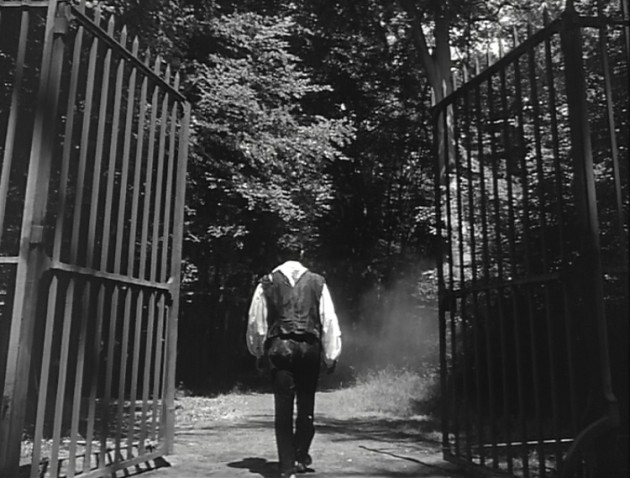
Magical gates…..to Heaven?
Another minor difference which eliminates twelve seconds of running time comes in the scene where the man appears on a tree-lined clearing and begins to run towards his home. In the original it cuts twice to his bloodied feet, but only once in the Twilight Zone version.
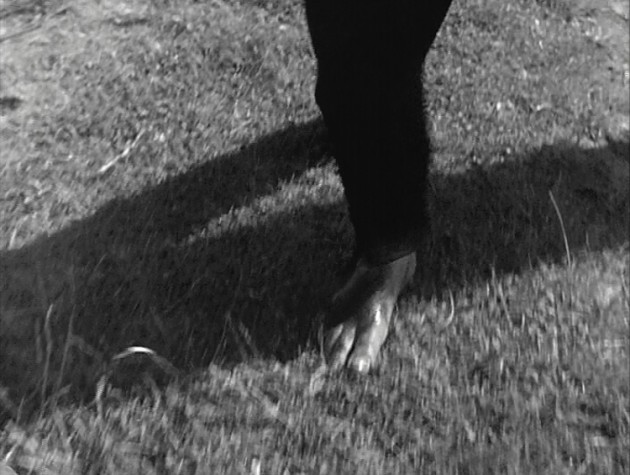
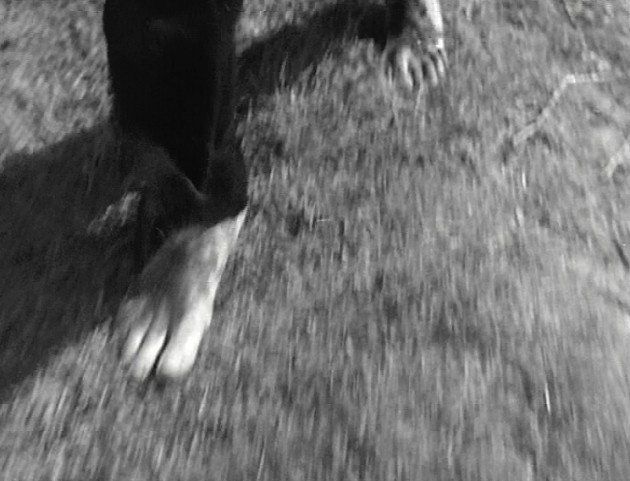
Two shots of feet in original
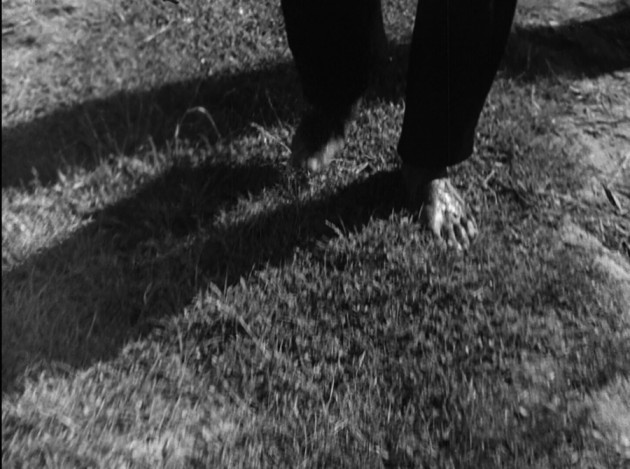
Only once in TZ version
As he nears his estate there are several formal cues that we are in a dream/fantasy state. Like the gates that seem to magically open by themselves; and most pointedly, the way moving POV camera, repetition, character gazes, the performance of the wife by Anne Cornaly, and spatial foreshortening estranges the moment of their union. It begins with a subjective POV shot that peers through moving foliage, to reveal Abby exiting the house in the background. As she walks toward the camera her gaze suggests she is looking at someone in the near foreground, but when we cut back to Peyton he seems far back on the road and we do not see any foliage in his foreground. The subsequent montage culminating in their union confirms the oddness of the previous ‘pov’ shot by foregrounding the spatial gulf between them.
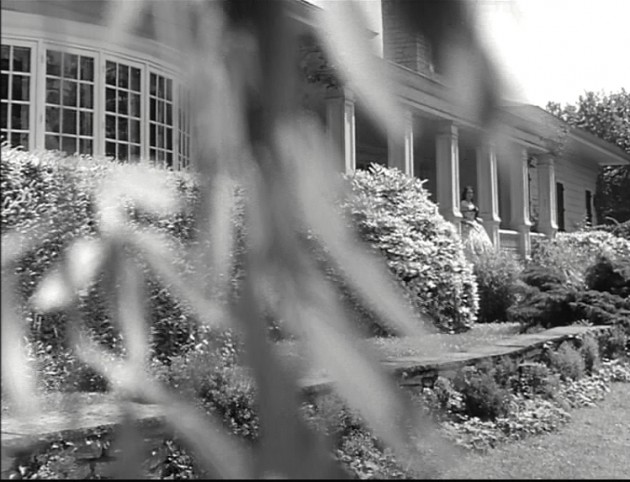
Deceptive subjectivity
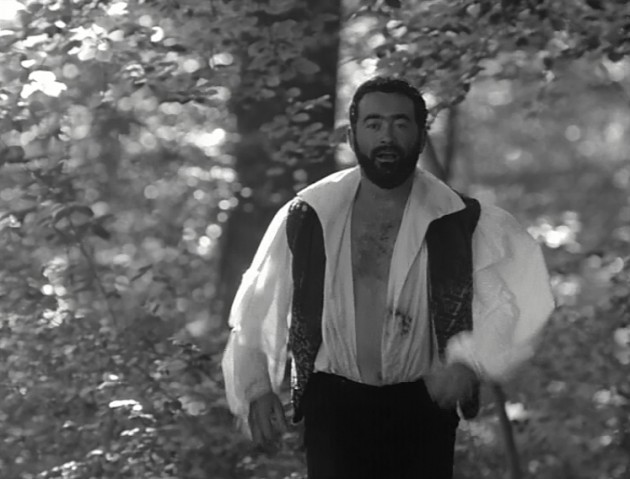
Still so far….
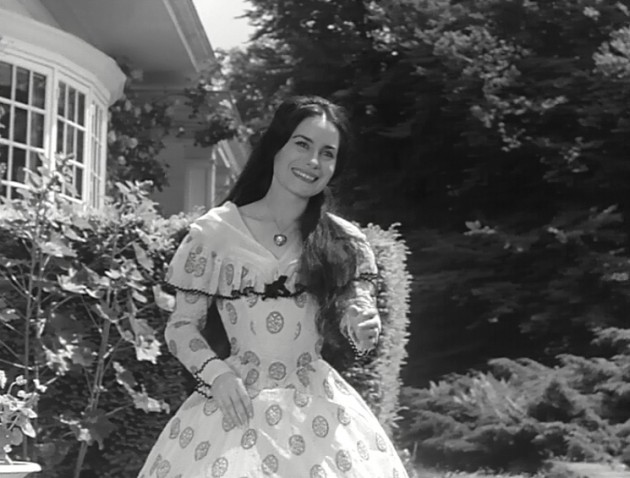
Abby…..
As the imminent meeting between Peyton and his wife Abby nears, there is a surreal montage cutting between Abby walking to greet her husband four times, and Peyton running to greet her with open arms, five times. Time is estranged through Abby’s repetitive movements, her fixed grin, and the use of telephoto lens which makes Peyton appear to be running in place. We see Abby begin to walk down the few steps at the end of her front landing in her second shot but in the third shot she is back on the top landing and steps down onto the first step again, creating a dream-like sense of repetition (maybe influenced by the washer woman in Leger’s Ballet Mecanique?), which is underscored by her fixed facial expression. On the fifth shot of Abby we hear (in the original version) the fifth instance of voice-over, “Abby.” They finally meet in the same frame, and we hear “Abby” again, but do not see his mouth moving, another strong indicator that we are not in reality. As he moves to kiss Abby, his head snaps back (as it will in the ‘real’ moment in time) and we jarringly cut to the present, to reality, as his corpse falls into its final hanging position, creating one of the cinema’s greatest twist endings.

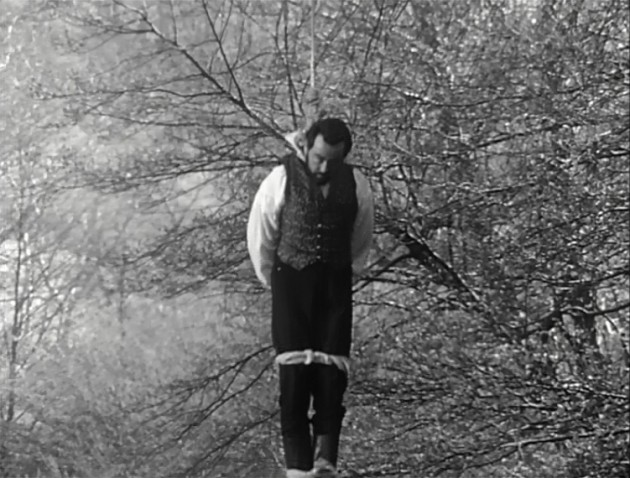
A literal SNAP back to reality
A second major difference (along with the removal of four instances of voice-over) between the two versions comes in the ending. Both versions cut back to reality as we are ‘snapped’ by the twist revelation that the man is hanging to his death, bringing home with a dull thud the realization that the events pictured have been the condemned man’s fantasy, or the proverbial ‘life flashing before your eyes” at the moment of death. At this point in the original version, as in the Twilight Zone version, the shot zooms out from a long shot of the man hanging to a full shot of the bridge. The soldiers begin to march away and then the camera pans and begins to track to the right into the nearby heavily wooded forest. At this point in the Twilight Zone version as soon as the camera begins to pan right into the woods we hear host Rod Serling’s voice-over: “An Occurrence at Owl Creek Bridge, in two forms, as it was dreamed and as it was lived and died. This is the stuff of fantasy, the thread of imagination, the ingredients of the Twilight Zone,” and then the image fades to black; after a commercial break Serling returns to set up the next installment of Twilight Zone and the film returns to the final end credits of An Occurrence at Owl Creek Bridge over a freeze frame of the forest. Serling’s voice-over leaves no room for ambiguity. However, in the original 1962 version the camera continues to pan and then track right into the forest. There is no voice-over to explain what we have seen. We see an intertitle that repeats the government public order of the opening intertitle, now in French, and then the image continues to track right past more trees, while the credits roll. The camera movement continues this way with subtle dissolves perhaps masking the actual direction of the camera, which continues screen right but begins to also move in a circular motion; because the camera is always moving screen right –even with the semi-circular turning movement– we are surprised when the camera brings us back to the original bridge position with the man still seen hanging off the bridge, with a sole sentinel pacing on the bridge, as if the camera has travelled in a complete 360 degree arc. The camera zooms in slightly then stops on the still extreme long shot of the dead man hanging in mid-air, bringing a sense of finality to the proceedings, but also an aura of mystery given the unreadable trajectory of the camera movement. The return to the bridge suggests a metaphorical reading of the bridge as a liminal space between reality and illusion, life and death. In removing this final movement back to the bridge, the Twilight Zone version, while obviously saving necessary running time, removes any possible ambiguity or confusion that may have been caused by the spatial orientation of the camera movements –perhaps a concession to the more conventional TV audience.
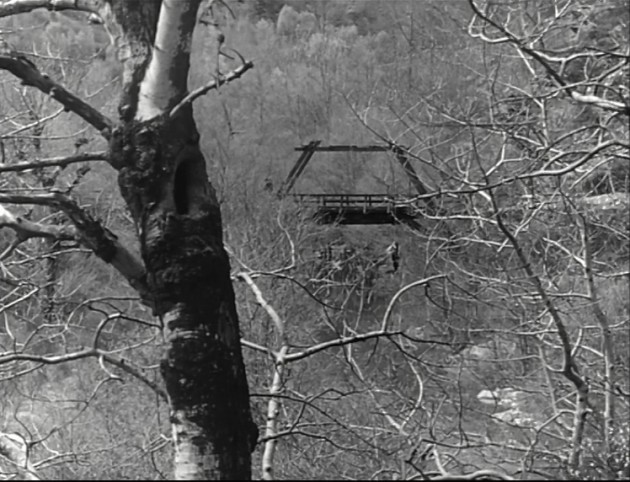
Final shots in original
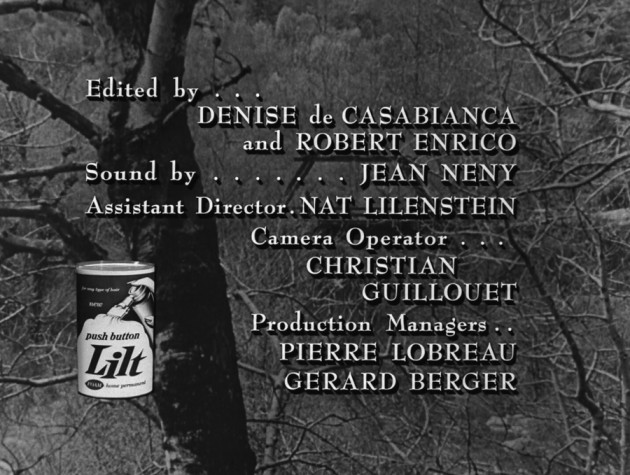
Final shot in TZ version
There is another obvious point which may play into the audience’s reading of the film: the mere appearance of this film on the Twilight Zone television show, known to feature fantasy, science-fiction and horror, is an indicator that something is up and perhaps weakens the punch of the twist ending. Since the Twilight Zone rarely featured straight drama a viewer may have been prepared to expect the unexpected.
In conclusion, Enrico’s version can be said to be more faithful to Bierce’s original story largely because it’s greater use of the subjective voice-over helps to balance out the play between realism and fantasy that Bierce was able to instill through language and the disarming use of third person authorial narration. After-all, the story begins with an air of documentary objectivity: “A man stood upon a railroad bridge in northern Alabama, looking down into the swift water twenty feet below.” But then introduces subtle hints of ambiguity into the third person authorial narration: “As Peyton Farquhar fell straight downward through the bridge he lost consciousness and was as one already dead [my emphasis].” As a reader we do not intuitively grasp the impossibility or oddness of some of the third person narration, such as the notion that Peyton could actually see the color of his shooter’s eyes through the rifle’s sights at such a far distance. Or the idea that he heard “whispers in an unknown tongue.” If both he and the Northern soldiers spoke same the language, English, what could that other tongue be? As an added observation, there was an even earlier adaptation which appeared in 1959 on the television show “Alfred Hitchcock Presents” which is the only version to provide the back-story/flashback which we get in section two of the original story, which sets up how Peyton Farquhar, loyal to the Southern cause, had plans to set the bridge afire to stop the Yanks from crossing over and gaining territorial ground.
Below are links to viewing the two different versions of the Ambrose Bierce story discussed above.
Twilight Zone version:
Original Enrico version:
(English version of the film, which is identical in length to the version discussed above, except for the omission of the French voice-over narration)
Interview with Twilight Zone producer William Froug, who discusses working with Rod Serling and how they optioned the Bierce story.
Notes
- The Twilight Zone: Unlocking the Door to a Television Classic by Martin Grams, cited in Wikipedia entry on the film. ↩
- This oddness in language switching comes through only in the original French version, where we hear the Northern soldiers speak in English, but hear Peyton’s subjective voice-over spoken in French. If for realism purposes the Northern soldiers speak English, why wouldn’t the Southerner? One reason could be a line in the novel, where the narrator says Peyton heard “whispers in an unknown tongue.” To make matters more confusing for keeping track of differences, it is only the French release of the film (represented by the PAL release DVD pictured above) that contains the French subjective voice-over. In English versions of the Enrico version, which runs the same length of 26’40”, the voice-overs are, like in the Twilight Zone version, removed. This is a consequence of the film being produced for a French market, but in the French version one would expect subtitles for the spoken English, but there are none on the French Pal release DVD. ↩



